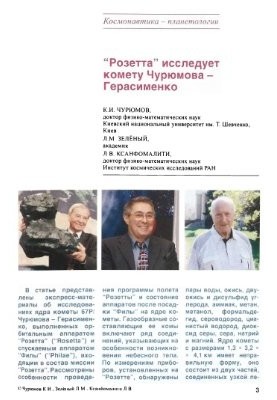Rosetta explores the comet Churyumov - Gerasimenko
 Instant download
Instant download
after payment (24/7)
 Wide range of formats
Wide range of formats
(for all gadgets)
 Full book
Full book
(including for Apple and Android)
Article. Published in Earth and Universe 2015. — No4. The article presents express materials on studies of the nucleus of comet 67P/ Churyumov-Gerasimenko, performed by the Rosetta orbiter and the Philae lander, which is part of the Rosetta mission. Features of the Rosetta flight program and the state of the spacecraft after the landing of the Philae on the comet nucleus are considered The gaseous components of its coma include a number of compounds indicating the features of the emergence of a celestial body. According to the measurements of the devices installed on Rosetta, water vapor, oxide, carbon dioxide and disulfide, ammonia, methane, methanol, formaldehyde, hydrogen sulfide, hydrogen cyanide, sulfur dioxide, sulfur, sodium and magnesium were found. The comet's nucleus, measuring 1.3 3.2 4.1 km, is irregularly shaped, consisting of two parts connected by a narrow jumper. The Rosetta images show rough fractures of the surface, steep mountain slopes dotted with dips, ridges and blocks, and small plain fields covered with fragmented material.. Underneath the top layer, a hard rock was found that could not be drilled and hammered. Due to the unsuccessful landing of the lander Phila, a number of experiments on the surface of the comet's nucleus could not be performed.
LF/938908482/R
Data sheet
- Name of the Author
- Зеленый Л.М.
Ксанфомалити Л.В.
Чурюмов К.И. - Language
- Russian













